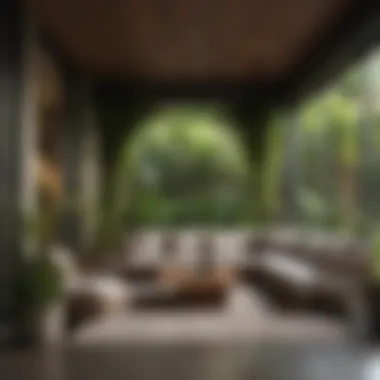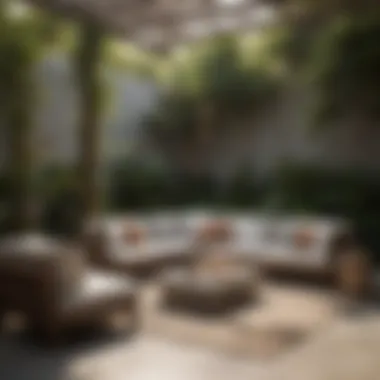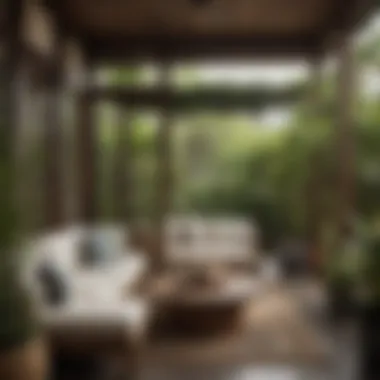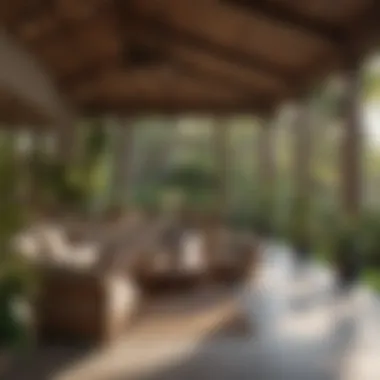Creative Lanai Concepts for Modern Homes


Intro
The lanai, a term of Hawaiian origins, refers to a type of balcony or porch that seamlessly connects the indoors with the outdoors. This architectural feature has gained popularity in modern design as a way to expand living spaces and enhance the overall aesthetic of homes. With the rise in the focus on outdoor living, homeowners are looking for innovative ways to utilize their lanai areas, transforming them into multifunctional spaces that mirror their personal style and needs.
The significance of a well-designed lanai extends beyond mere decoration; it plays a crucial role in enhancing comfort, sustainability, and even social interaction. As families and individuals seek to create environments that foster connection and relaxation, the lanai becomes a canvas for creativity. This article will provide an overview of current trends, practical tips, and innovative ideas that align with contemporary living while considering elements like sustainability and comfort.
Key Insights and Trends
Current Trends in Interior Design
Modern interior design trends emphasize the blending of indoor and outdoor spaces. This is particularly evident in the increasing use of glass walls or large sliding doors that open up to a lanai. Such features not only invite natural light but also create an open feel that encourages movement between spaces.
Among the latest styles, minimalism plays a prominent role. Homeowners are leaning towards clean lines and simple color palettes in their lanai designs. Earth tones, such as browns, greens, and soft whites, dominate the color spectrum this season. Soft textures and materials like rattan, bamboo, and reclaimed wood also gain preference, reflecting a commitment to eco-friendly practices.
Popular Gardening Techniques of the Season
Garden enthusiasts are incorporating innovative techniques to enhance their lanai spaces. Vertical gardening, for example, allows for more greenery without consuming valuable floor space. Living walls or trellises can provide shade while acting as stunning visual features.
Container gardening continues to thrive, with decorative pots becoming integral to lanai design. Homeowners opt for herbs and decorative plants aligned with sustainable practices. Moreover, the use of native plants ensures lower maintenance and better adaptability to the local environment.
Practical Tips and How-To Guides
Step-by-Step Guides for Home Decoration Projects
- Define your purpose: Before decorating, consider how you intend to use the lanai. Is it for family gatherings, quiet relaxation, or entertaining guests?
- Choose the right furniture: Invest in durable, weather-resistant furniture. For a comfortable seating area, consider sectional sofas or lounge chairs with cushions.
- Incorporate plants: Bring life to your lanai with various plants. Use hanging baskets, potted plants, or vertical gardens tailored to your design theme.
- Lighting selection: Adequate lighting can transform a lanai for evening use. Consider string lights or lanterns to create an inviting atmosphere.
- Decorative elements: Add personal touches with rugs, throw pillows, and artwork that resonate with your style.
Entertaining Tips and Planning Checklists
To host a successful gathering on your lanai, consider the following:
- Seating arrangement: Ensure enough seating for your guests without overcrowding.
- Food and drinks: Plan a menu that allows for easy serving, such as finger foods and refreshing beverages.
- Ambiance: Use candles and decorative lights to create a warm environment as the sun sets.
- Entertainment options: Prepare games or background music to keep your guests engaged.
"The key to a successful lanai is adaptability. A space should transition smoothly from day to night and cater to different needs throughout the year."
By implementing these insights and practical guidance, homeowners can thoughtfully design their lanai spaces to reflect modern living while enhancing functionality and sustainability.


Understanding the Concept of a Lanai
The concept of a lanai is rooted in functionality and aesthetic appeal. Lanai, often associated with Hawaiian architecture, serves as a blend between indoor and outdoor living. Embracing this idea can greatly enhance how we experience and utilize our homes. This section discusses the origins, characteristics, and modern interpretations of lanai spaces to enrich understanding and appreciation for homeowners and design enthusiasts.
Origins and Historical Significance
The term "lanai" can be traced back to Hawaii, where it signifies a porch or veranda that connects indoor spaces with the outdoors. Traditionally, these structures were designed to provide shade from the sun and protection from rain, allowing residents to enjoy the beauty of their surroundings without fully exposing themselves to changing weather conditions. This adaptation of outdoor space reflects a historical significance that prioritizes both comfort and nature appreciation.
In the context of Hawaiian culture, the lanai is more than just an architectural feature; it represents a lifestyle that integrates natural beauty into daily living. As people from various backgrounds created their homes in warmer climates, the idea of a lanai spread. It adapted to local contexts and preferences while maintaining its core function of blending indoor comfort with outdoor scenery.
Modern Interpretation of Lanai Spaces
In contemporary design, the interpretation of a lanai has evolved. Modern homeowners utilize these spaces not only for leisure but also as extensions of their living areas. Here, a lanai can serve multiple purposes, from a family gathering place to an intimate, quiet retreat. Below are some key aspects of modern lanai designs:
- Flexibility: Modern lānai can be designed to adapt to different occasions—whether it's hosting friends for dinner or enjoying a book alone.
- Comfortable Furnishings: Different seating options, such as outdoor sofas and lounge chairs, are essential for creating an inviting atmosphere. This focus on comfort can elevate the overall aesthetic while encouraging social interaction.
- Integrated Technology: With advancements in technology, lanai spaces now often feature outdoor entertainment systems and climate control options. Implementing these features can further enhance the usability of the space throughout the year.
- Natural Elements: Modern designs emphasize incorporating greenery and natural materials, creating a seamless connection to the outdoors. This approach can improve air quality and offer soothing visuals, completing the essence of what a lanai represents.
"Lanai spaces offer an essential balance between indoor and outdoor living, enriching the home experience."
By understanding the lanai's historical roots and its modern interpretations, homeowners can appreciate the potential that these spaces hold. They provide not only an addition to their property but also an opportunity to embrace nature and enhance daily living.
Functional Benefits of a Lanai
The concept of a lanai extends far beyond mere aesthetics; it serves significant functional purposes in modern living spaces. When designed thoughtfully, a lanai can enhance lifestyle quality while fostering a harmonious connection between the indoors and outdoors. The benefits are multifaceted, offering practical solutions for homeowners who seek to expand their living environments.
Expanding Living Space
One of the most noteworthy benefits of a lanai is its ability to create additional livable area. This space can function as a family gathering spot or a tranquil personal retreat. The versatility of a lanai allows it to adapt to various needs. For instance, during the warmer months, it can serve as an informal dining area or recreational space for children and family. In colder months, with adequate heating solutions, it can transform into a cozy nook for reading or relaxation.
Moreover, adding a lanai can also increase a home’s overall property value. Buyers often prefer homes with outdoor access. This area can be marketed as an extension of the home itself. Flexible space that offers utilization year-round can appeal to prospective buyers, making it a worthwhile investment for homeowners.
Enhancing Indoor-Outdoor Flow
In addition to spatial benefits, a lanai enhances the transition between indoor and outdoor living. A well-designed lanai creates seamless access to outdoor settings, promoting an atmosphere of freedom and fluidity in space usage. Large sliding doors or bi-fold systems can allow a full transition to the outdoors, which improves air circulation and natural light.
Integrating a lanai into home design encourages a lifestyle that embraces nature. Homeowners may find themselves spending more time outside, enjoying fresh air and natural sunlight without sacrificing comfort. This connection to the natural world can greatly enhance one’s quality of life, contributing to physical well-being and mental relaxation.
"The lanai is not just a transitional space; it stands as a pillar of modern living that unites interior functionality with the beauty of the outdoors."


In summary, a lanai serves critical functional purposes that benefit homeowners. From expanding living space to enhancing the indoor-outdoor flow, a lanai reflects thoughtful design that boosts comfort and convenience. These factors make the lanai an essential element for enhancing modern living environments.
Design Considerations for a Lanai
Designing a lanai requires careful thought and planning, as it plays a pivotal role in creating a seamless blend between indoor and outdoor living spaces. The right design can transform a simple area into a functional and aesthetically pleasing extension of your home. Key elements to consider include space assessment, layout optimization, and appropriate material selection. Each aspect significantly impacts usability, comfort, and the overall visual appeal.
Assessing Space and Layout
Assessing the available space is essential before embarking on your lanai project. Consider the existing architecture and how the lanai integrates with current structures. This assessment helps in determining the appropriate size and dimensions for the space. It is advisable to envision the lanai as an extension of your indoor living areas, allowing you to plan the layout effectively to facilitate movement and interaction.
To maximize the functionality of the lanai, consider common uses, such as dining, lounging, or gardening. This insight will help dictate furniture arrangement and design. Ensuring adequate flow between the main living space and the lanai can enhance connectivity and ease of use, fostering a comfortable environment.
Choosing Appropriate Materials
Material selection greatly influences the durability and appearance of the lanai.
Wood
Wood is a favored choice due to its natural beauty and warm aesthetic appeal. It adds a rustic charm to the space, creating a cozy atmosphere. The key characteristic of wood is its versatility; it can be shaped and finished in various styles to match the overall design theme.
However, wood does have some drawbacks, such as vulnerability to moisture and pests. Regular treatment and maintenance are required to preserve its condition, especially in climates with high humidity.
Composite Materials
Composite materials offer a modern alternative to traditional wood. These materials consist of a mixture of wood fibers and plastic, making them more resistant to environmental factors. The standout characteristic of composite materials is their low maintenance requirements, as they do not need painting or staining like wood.
While composites often mimic the appearance of wood, they may lack the same organic feel. However, their durability and resistance to fading and staining make them a practical option for many homeowners.
Glass Structures
Glass structures provide a unique aesthetic that can enhance the visual openness of a lanai. Their transparency allows for unobstructed views and ample natural light, making the space feel larger and more inviting. The primary advantage of glass is its elegant appearance, especially when combined with appropriate framing materials.
Nevertheless, glass requires careful handling and maintenance, as it can be prone to scratches and marks. Ensuring that the glass is treated for UV resistance can help mitigate some of these issues.
In summary, the choice between wood, composite, or glass materials should align with your personal style, environmental conditions, and the intended use of your lanai.
The design of your lanai is not merely a cosmetic undertaking. It reflects your lifestyle and enriches your living experience, bringing an essential balance between nature and modern living.


Lanai Furniture Selection
Selecting furniture for a lanai is crucial for creating a space that is both inviting and practical. The right furniture enhances not only the aesthetic appeal of the area but also its functionality. When it comes to lanai, the furniture must withstand outdoor conditions while delivering comfort and style. Thoughtful selection of lanai furniture can transform this space into an extension of the home, facilitating relaxation and social interactions among family and friends.
Choosing Durable and Stylish Options
Outdoor Sofas
Outdoor sofas are a central piece for any lanai. They provide the comfort you expect from indoor seating but are designed for outdoor conditions. One key characteristic of outdoor sofas is their resilience against elements such as rain and sunlight. This makes them a popular choice, especially in areas with variable weather. A unique feature of many outdoor sofas is the use of UV-resistant fabrics, which prolongs their lifespan. While these sofas offer significant advantages like comfort and style, their initial cost can be higher than average indoor sofas. However, the long-term value and durability often justify this investment.
Dining Sets
A well-designed dining set can elevate the functionality of your lanai. One of the most significant aspects of dining sets is their ability to host meals outdoors, creating a seamless indoor-outdoor experience. Dining sets typically come in weather-resistant materials like aluminum or teak, which are known for their longevity. Their versatility allows them to cater to small gatherings or large parties, depending on the configuration. A potential disadvantage may include the need for regular maintenance to keep them in ideal condition, particularly with wooden options. However, the aesthetic and social benefits often outweigh these minor inconveniences.
Lounge Chairs
Lounge chairs are pivotal for relaxation on your lanai. They serve as personal retreats where one can unwind with a book or enjoy a refreshing drink. A key feature of modern lounge chairs is their ergonomic design, fostering comfort during longer periods of sitting. Many designs incorporate adjustable features, allowing users to customize their seating position. While these chairs contribute significantly to the relaxation aspect of a lanai, it is essential to consider that some may require more space than initially anticipated. Overall, lounge chairs are a worthwhile investment for enhancing leisure time outdoors.
Incorporating Functionality
Storage Solutions
Incorporating storage solutions into your lanai is vital for maintaining order and functionality. Storage items such as benches with hidden compartments or outdoor cabinets can effectively manage space and keep essentials nearby. A highlighting feature of these storage solutions is their dual purpose; they add seating or surfaces while concealing clutter. This practicality makes them a highly valued choice for any lanai. One potential drawback is that not all storage solutions are weather-proof, which may require additional care to protect them from elements. Choosing the right type can mitigate this issue and streamline outdoor living.
Convertible Furniture
Convertible furniture maximizes the potential of your lanai by providing flexible options tailored to different uses. This kind of furniture can change forms, like a coffee table transforming into a dining table or seating that can be rearranged for various events. The key benefit of convertible furniture is its adaptability, allowing homeowners to use the lanai for relaxation one day and entertaining the next. Unique to this style is the emphasis on space-saving design, which is excellent for smaller areas. Critics may argue that convertible options may not always provide the same level of comfort as traditional furniture; however, many modern designs successfully bridge that gap.
"Selecting the right furniture can significantly impact the comfort and functionality of your lanai, making it an extension of your home."
Decorating Your Lanai
Decorating your lanai holds significant merit within the context of modern living spaces. It transforms what could be a simple outdoor area into an extension of your home that showcases personal style and functional design. Thoughtful decoration enhances aesthetic appeal and creates a welcoming atmosphere for relaxation and social gatherings. Considering various elements, such as color schemes, textiles, and natural elements, can elevate the lanai from a mere afterthought to a desirable living space.
Color Schemes and Textiles
The choice of color schemes can dramatically affect the mood of your lanai. Opting for hues that resonate with the surrounding environment fosters harmony. Neutral tones, like soft grays or beiges, can form a subtle backdrop, allowing vibrant accents to shine through. On the other hand, bold colors, such as deep blues or rich greens, can inject energy and vibrancy into the space.
Textiles are equally important. The right cushions, throws, and rugs can add comfort and warmth. Weather-resistant fabrics ensure durability while retaining style. Fabrics that feature patterns can introduce an element of playfulness. Consider mixing textures—think cotton, linen, or even synthetic blends—to enhance visual interest.
- Neutral colors for a calming effect
- Bold accents for an energizing atmosphere
- Weather-resistant materials for longevity
- Textured fabrics for visual depth



